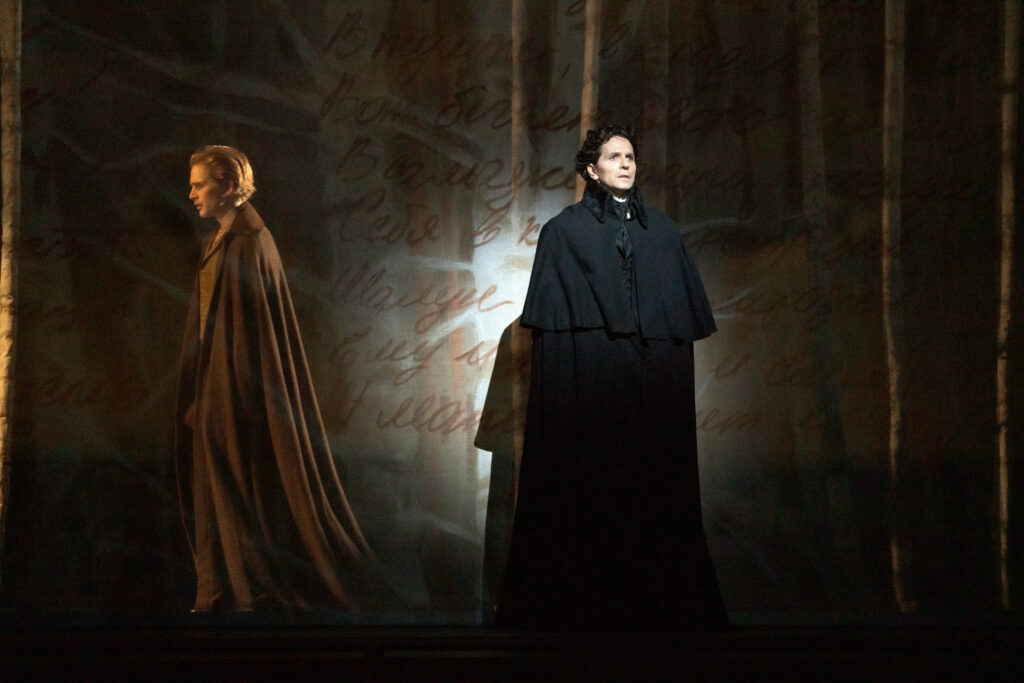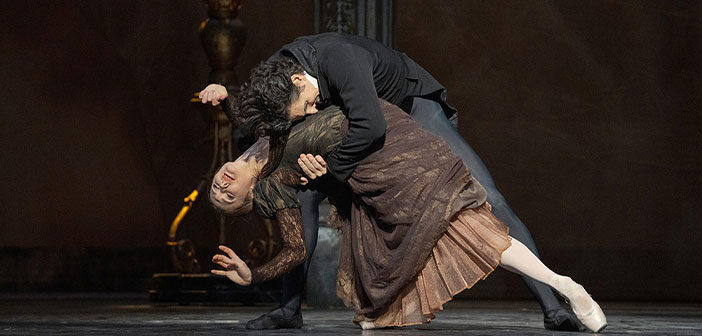The lights went out, and the music of Peter Ilyich Tchaikovsky filled the hall. Music Director and Principal Conductor David Briskin’s baton could barely be seen by the audience as he communicated with the musicians in the pit and the dancers on stage, so as to tell the story of Alexander Pushkin’s verse novel, Eugene Onegin.
John Cranko’s brilliant choreography holds an important place in the dance world, and has a particular connection with the National Ballet of Canada, as noted by Artistic Director Hope Muir in the detailed program notes. The ballet was redesigned in 2010 with period sets and beautiful costumes by Santo Loquasto, and lighting by James F. Ingalls. As apparent from the pre-performance chat, many of those present on November 22 had seen the National Ballet’s Onegin and were happily back for more.
Half comedic and half melancholic, Pushkin’s verse mixes cold intellectual observations with tearful impressions of the heart. The six principal dancers (Guillaume Côté as Onegin, Jurgita Dronina as Tatiana, Tina Pereira dancing Olga, Harrison James as Lensky, Ben Rudisin as Prince Gremin, and Stephanie Hutchison as Madame Larina) and the corps delivered personal, emotional performances that tackled the flaws of human nature with honesty. Who has not experienced aspirational romantic fantasies and been met with rejection, been disappointed by fickle friendship, looked back to be overcome by remorse and suffered grief over loss? Could have, would have, should have: anxieties that plague the human condition, revelations that were performed expertly by the musicians and dancers.

Harrison James and Guillaume Côté in Onegin (Photo by Karolina Kuras)
The set designs were extremely beautiful. For two hours and 20 minutes, over three acts (separated by intermissions) the dancers performed superhuman physical feats with grace and elegance against a stunning backdrop, in magnificent costumes. The intermissions were well deserved.
The music is based on a selection of Tchaikovsky’s piano works, his opera Cherevichki, and an excerpt from his tone poem, Francesca da Rimini. While the pieces were not specifically written for dance, or for this story, Cranko has selected music by Tchaikovsky that comes together to form what Conductor Briskin refers to as “a pastiche of gorgeous and expansive Russian melodies that weave their way through the emotional world that Onegin explores”.
Conductor David Briskin has an international reputation for his ability to communicate the co-dependency of musicians and dancers, and has conducted Onegin many times throughout North America. Under Briskin’s leadership, audiences experience the interplay of music and dance, as his interpretation elevates facile to formidable.
Comments exchanged by audience members during the intermissions and after the performance buzzed with excitement and appreciation for the ebb and flow of both the music and the dancing. Conductor Briskin and the orchestra members stretched the music’s rhythmic phrasing to support the dancers without compromising the metric structure of the score. The whole performance was a marked by the connection between music and dance, musicians and dancers. Maestro Briskin’s interpretation successfully drew the beauty of melodic motifs out of the score, and onto the stage. The buildup to the final pas de deux was particularly memorable, and made Tatiana’s expression of grief (danced by Jurgita Dronina) all the more impactful.
The applause was deafening, as multiple standing ovations expressed adoration for the dancers and musicians. For those who were unable to attend the opening, the ballet will run until November 26. There is reason to return even for those who were able to attend the first performance, as the cast will vary throughout the weekend, and the story will surely seem slightly different with each performance. The music and choreography will thus retain the freshness of opening night, again and again.
For more on Onegin, and the National Ballet of Canada: https://national.ballet.ca/Productions/Onegin















